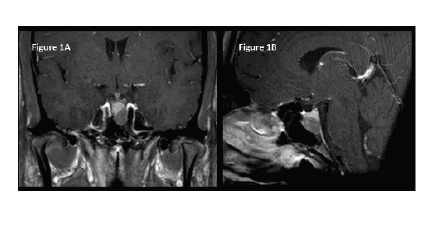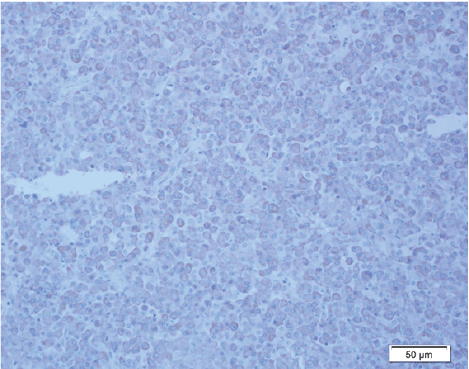
Figure 1: A and B) Pituitary MRI revealed a 1.4 cm × 1.2 cm × 0.8 cm ovoid hypoenhancing sellar mass.

Judith C Generoso Thanh D Hoang* James C Clifford Alfred F Shwayhat
Department of Internal Medicine, Division of Endocrinology, Naval Medical Center, San Diego, CA, USA*Corresponding author: Thanh D Hoang, Department of Internal Medicine, Division of Endocrinology, Naval Medical Center, San Diego, CA, USA, Tel: 619-532-7375; E-mail: thanh.d.hoang.mil@mail.mil
Acromegaly; Papillary Thyroid Cancer; Clinical Vignette
Acromegaly is a rare disease presentation in the general population. The relationship between thyroid cancer and acromegaly may seem rare however there is evidence showing a higher incidence of thyroid cancer in acromegalic patients. It would be important to consider the potential for thyroid disease in these patients. We present an interesting case of a man with history of thyroid cancer and a new diagnosis of acromegaly.
A 31 year old male with history of papillary thyroid cancer (tall cell variant) presents with endorsement of weight gain, increased hand and shoe size, hyperhidrosis, and decreased physical performance. Family history is notable for diabetes on his father’s side. Exam was notable for coarse facial features, macrognathia, frontal bossing, hypertrophic thyroidectomy scar, large doughy hands, and enlarged digits. Laboratory results revealed insulin like growth factor-11044 ng/mL (88-246), growth hormone 34.2 ng/mL (0.0-10.0), thyrotropin 0.641 mIU/mL (0.27-4.20), and free thyroxine 1.960 ng/dL (0.890- 1.760). Pituitary MRI revealed a 1.4 cm × 1.2 cm × 0.8 cm ovoid hypoenhancingsellarmass (Figures 1A and 1B).

Figure 1: A and B) Pituitary MRI revealed a 1.4 cm × 1.2 cm × 0.8 cm ovoid hypoenhancing sellar mass.

Figure 2: Pathology showed a plurihormonal adenoma with positive immunostaining for growth hormone in a significant number of cells, as well as diffuse staining for chromogranin and synatophysin.
Clinical features, biochemical testing, and imaging reveal a pituitary macro adenoma confirming a diagnosis of acromegaly. OGTT was not performed. Prolactin, luteinizing hormone, follicle stimulating hormone, cortisol, and thyroid function tests were normal. Patient underwent a transphenoidal hypophysectomy without complications. Pathology showed a plurihormonal adenoma with positive immunostaining for growth hormone in a significant number of cells, as well as diffuses staining for chromogranin and synatophysin (Figure 2).
Acromegaly is a rare disease caused by increased GH secretion and is associated with greater risk of developing both benign and malignant tumors. The clinical diagnosis is often delayed because of the slow progression of the acromegalic signs. Recent studies reveal an increase in cancer in patients with a known diagnosis of acromegaly which leads to the assumption that cancers are typically diagnosed later in these patients. Thyroid cancer is the most common malignancy diagnosed in acromegalic patients [1-3] and malignancies are the cause of death in 15% [2]. Acromegaly is also known to be associated with diffuse and nodular goiters. Thyroid cells express the IGF-1 receptor and a TSH/IGF-1 interaction has been demonstrated to have a synergistic effect in thyroid cell growth. Recent studies havefound an increased prevalence of nontoxic nodular goiter and a slightly or moderately increased prevalence of thyroid carcinoma. The assumed pathogenesis in patients with acromegaly is that thyroid carcinoma develops following a sustained exposure to high serum IGF-1 levels [3].
The fact that acromegaly appears to be a risk factor for developing malignancy may have led to improved surveillance for cancer in these patients. This case demonstrates that it is important to be aware of the association of various cancers, especially thyroid cancer, with acromegaly.
The views expressed in this article are those of the authors and do not necessarily reflect the official policy or position of the Department of the Navy, Department of Defense, or the U.S. Government. We certify that all individuals who qualify as authors have been listed; that each has participated in the conception and design of this work, the analysis of date, the writing of the document, and the approval of the submission of this version; that the document represents valid work; that if we used information derived from another source, we obtained all necessary approvals to use it and made appropriate acknowledgements in the document; and that each takes public responsibility for it.
Download Provisional PDF Here
Article Type: Case Report
Citation: Generoso JC, Hoang TD, Clifford JC, Shwayhat AF (2016) Thyroid Cancer and Acromegaly: A Case Report. J Clin Case Stu 1(2): doi http://dx.doi.org/10.16966/2471-4925.107
Copyright: © 2016 Generoso JC, et al. This is an open-access article distributed under the terms of the Creative Commons Attribution License, which permits unrestricted use, distribution, and reproduction in any medium, provided the original author and source are credited.
Publication history:
All Sci Forschen Journals are Open Access